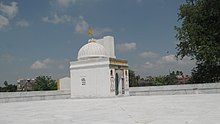

Acharya
Sthulabhadra
Suri
| |
|---|---|

Sthulabhadra Jain temple in Kamaldah, Patna
| |
| Preceded by | Acharya Bhadrabahusuri |
| Succeeded by | Acharya Mahagirisuri and Acharya Suhastinsuri |
| Personal | |
| Religion | Jainism |
| Parent |
|
| Sect | Śvetāmbara |
| Religious career | |
| Teacher | Acharya Sambhutavijayasuri |
| Part of a serieson |
| Jainism |
|---|
 |
|
|
|
Ethics
Ethics of Jainism
|
|
Jain prayers |
|
Major figures |
|
Major sects |
|
|
|
Festivals |
|
Pilgrimages |
|
Other |
|
|

Sthulabhadra (297-198 BCE) was a Jain monk who lived during the 3rd or 4th century BC. He was a disciple of Bhadrabahu and Sambhutavijaya. His father was Sakatala, a minister in Nanda kingdom before the arrival of Chandragupta Maurya. When his brother became the chief minister of the kingdom, Sthulabhadra became a Jain monk and suceeded Bhadrabahu in the Pattavali as per the writings of the Kalpa Sūtra.[1] He is mentioned in the 12th-century Jain text Parisistaparvan (appendix to the Trisasti-shalakapurusa-caritra) by Hemachandra. [2]
Sthulabhadra was a son of the Dhana Nanda's minister Sakatala and brother of Shrikaya.[3][4] He is traditionally dated in 297 to 198 BCE.[3] He loved and lived with a royal dancer in Dhana Nanda's court named Rupkosa.[3][4] He denied ministry after the death of his father and became a Jain monk.[5] His brother became the chief minister in Nanda empire later.[6][4] He became a disciple of Sambhutavijaya (347-257 BCE) and Bhadrabahu (322-243 BCE).[7][4][8] He led an ascetic life for 12 years.[6]

He spent his chaturmas at Rupkosa's home, during which she tried to lure him away from ascetic life but failed.[6] Sthulabhadra in turn gave her vows of a Shravika (Jain laywoman).[6]
He is said to have learned only 10 purvas (pre-canons with meanings) from Bhadrabahu. Although he knew the last 4 purvas as well, but since he did not know the meaning associated with them, he is not considered to have been a Shrutakevalin.[2] He was succeeded by his disciples Acharya Mahagirisuri and Acharya Suhastinsuri, whom he taught only 10 purvas because Bhadrabahu had imposed a condition upon him that he would not teach the last 4 purvas to anyone because he had used the knowledge of purvas to display magical powers.[2][6][9] 10th century Digambara texts state that Sthulabhadra permitted the use loincloth during the 12-year famine, a practice that started the Śvetāmbara order, but is considered as baseless according to followers of the Śvetāmbara sect. Avashyak Bhashya, a 5th century Śvetāmbara text written by Jinabhadra claims that the Śvetāmbara sect had always existed and that the Digambara sect was created by a rebellious monk named Sivabhuti. [10][11][12]
Śvetāmbaras venerate Acharya Sthulabhadrasuri in the following hymn:[13]
मंगलं भगवान वीरो, मंगलं गौतम प्रभु। मंगलं स्थूलिभद्राद्या, जैन धर्मोस्तु मंगलं।।
Translated as:
Mangalam Bhagaväna Viro, mangalam Gautama prabhu, Mangalam Sthülibhadrädyä, Jaina dharmostu mangalam.
Meaning:
Bhagawän Mahävir is auspicious, Ganadhar Gautam Swämi is auspicious; Ächärya Sthulibhadra is auspicious, Jain religion is auspicious.
|
| |
|---|---|
| |
| |
| Branches |
|
| Ancient |
|
| Medieval |
|
| Modern |
|
Śvetāmbara ascetics | |
| Gacchas |
|
| Ancient |
|
| Medieval |
|
| Modern |
|
|
| |||||
|---|---|---|---|---|---|
| Gods |
| ||||
| Philosophy |
| ||||
| Branches |
| ||||
| Practices |
| ||||
| Literature |
| ||||
| Symbols |
| ||||
| Ascetics |
| ||||
| Scholars |
| ||||
| Community |
| ||||
| Jainism in |
| ||||
| Jainism and |
| ||||
| Dynasties and empires |
| ||||
| Related |
| ||||
| Lists |
| ||||
| Navboxes |
| ||||
| International |
|
|---|---|
| National |
|
This Jainism-related article is a stub. You can help Wikipedia by expanding it. |
This biography of an Indian religious figure is a stub. You can help Wikipedia by expanding it. |